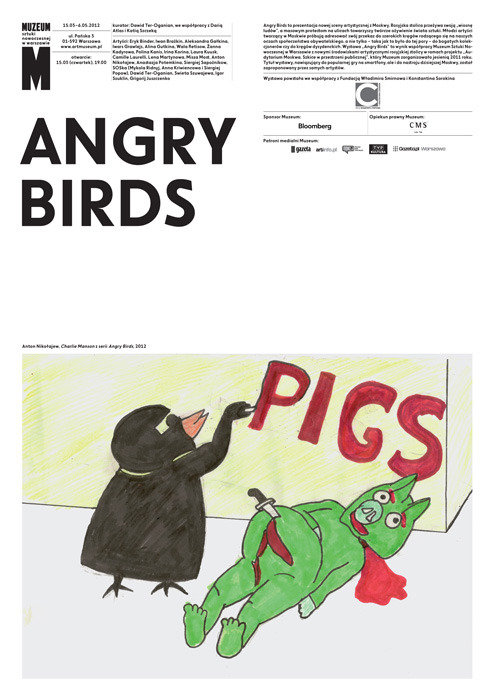Angry Birds
dal 14/3/2012 al 5/5/2012
Segnalato da
Eric Binder
Ivan Brazhkin
Alexandra Galkina
Ivars Gravlejs
Alina Gutkina
Valya Fetisov
Zhanna Kadyrova
Polina Kanis
Irina Korina
Laura Kuusk
Camille Laurelli
Lena Martynova
Misha Most
Anton Nikolaev
Anastasia Potemkina
Sergey Sapozhnikov
SOSка
Mykola Ridnyi
Anna Kriventsova
Sergey Popov
David Ter-Oganyan
Sveta Shuvaeva
Igor Shuklin
Grigory Yushchenko
David Ter-Oganyan
Daria Atlas
Katia Szczeka
14/3/2012
Angry Birds
Museum of Modern Art in Warsaw, Warsaw
Works of a young generation of artists, important for the Moscow art scene today, the exhibition includes also artists from former Soviet republics. The recent explosion of protests is a symptom of undercurrent of changes in the society and culture; the visitors will be surprised by unknown references, fantasies, and fears. This strangeness shows how little there was to connect the experiences of past 20 years in Poland and in Russia.

artists: Eric Binder, Ivan Brazhkin, Alexandra Galkina, Ivars Gravlejs, Alina Gutkina, Valya Fetisov, Zhanna Kadyrova, Polina Kanis, Irina Korina, Laura Kuusk, Camille Laurelli, Lena Martynova, Misha Most, Anton Nikolaev, Anastasia Potemkina, Sergey Sapozhnikov, SOSка (Mykola Ridnyi, Anna Kriventsova and Sergey Popov), David Ter-Oganyan, Sveta Shuvaeva, Igor Shuklin, Grigory Yushchenko.
curator: David Ter-Oganyan in cooperation with Daria Atlas and Katia Szczeka.
The exhibition presents works of a young generation of artists, important for the Moscow art scene today. It includes not just Russians, but also artists from former Soviet republics and from Western countries.
The scene changes as dynamically as the rest of Russian society but recently began sinking in apathy. Around 2000 radical artistic strategies, similar to those which operated effectively in Poland and the rest of Eastern Europe, were suppressed as the oppressive Putin regime consolidated its grip on power. The space for freedom has shrunk, as has the space for involved or critical art.
Its symbolic farewell was the action of Anatoly Osmolovsky and Radek group, during which the artists participated in the election campaign, by registering (and appearing on the voting sheet) with a slogan “Against everybody.” The winner in the election was, for the first time then, Vladimir Putin. His times brought about art which was adapted to the new order: very commercial, dissociated from social reality, financed by oligarchs.
The clearest example of this phenomenon is the Garage Center for Contemporary Culture created by Dasha Zhukova, life partner of multi-billionaire Roman Abramovich, where luxury art imported from New York is displayed. On the other hand, some of the artists have decided to go into political activism, often desperate, for which they were, and still are, imprisoned. A good example of that stream is the War group. Their most famous action, and reported by news services around the world, was painting, on a drawbridge in Petersburg, a gigantic penis which was raised for a few hours in front of the local seat of Federal Security Service.
The recent explosion of protests is a symptom of undercurrent of changes in the society and culture; “Angry Birds” exhibition tries to bring them closer to Polish viewers. However, the new phenomena emerging on Moscow art scene are too new to be completely understood. In viewing the exhibition, the visitors will be surprised by unknown references, fantasies, and fears. This strangeness shows how little there was to connect the experiences of past 20 years in Poland and in Russia.
Young artists from Moscow are trying to formulate their vision of the world based on new experiences, just being gained, of a society which is ready to face the challenges of today’s reality. The title they gave to the exhibition is Angry Birds – it refers to a popular game for smartphones, in which the birds (freedom supporters) fight the pigs (keepers of the old order) for stolen eggs (the future).
Warsaw Museum of Modern Art has gained the knowledge necessary to organize this exhibition by way of long-term research. It started with an international seminar “Where the West Ends?” organized in cooperation with British art theoretician Claire Bishop in March 2010. In the autumn of 2011, the Museum implemented the project Auditorium Moscow. Under the project, a platform for public debate, including art communities, has been created in Moscow. Its objective was to research the links between art and life of the society. Thanks to the project, the Museum came into direct contact with the young artists of this scene, which operates outside of the official institutional milieu and relies instead on personal social relationships and self-organization. The summary of research of contemporary art scene in Russia – as well as of the exhibition – shall be presented in a publication, planned by Museum of Modern Art this year.
The exhibition was co-financed by the Foundation of Vladimir Smirnov and Konstantin Sorokin
Press contact
Malwina Kusmierowska phone +48 22 5964010 fax +48 22 5964022 prasa@artmuseum.pl
Opening of the exhibition: 15 March (Thursday), at 19.00
Museum of Modern Art in Warsaw
ul. Panska 3 00-124 Warsaw Poland
open Tuesday-Sunday 12h00-20h00
admittance free



